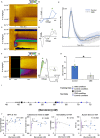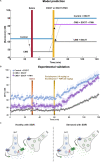A tale of two transmitters: serotonin and histamine as in vivo biomarkers of chronic stress in mice
- PMID: 35761344
- PMCID: PMC9235270
- DOI: 10.1186/s12974-022-02508-9
A tale of two transmitters: serotonin and histamine as in vivo biomarkers of chronic stress in mice
Abstract
Background: Stress-induced mental illnesses (mediated by neuroinflammation) pose one of the world's most urgent public health challenges. A reliable in vivo chemical biomarker of stress would significantly improve the clinical communities' diagnostic and therapeutic approaches to illnesses, such as depression.
Methods: Male and female C57BL/6J mice underwent a chronic stress paradigm. We paired innovative in vivo serotonin and histamine voltammetric measurement technologies, behavioral testing, and cutting-edge mathematical methods to correlate chemistry to stress and behavior.
Results: Inflammation-induced increases in hypothalamic histamine were co-measured with decreased in vivo extracellular hippocampal serotonin in mice that underwent a chronic stress paradigm, regardless of behavioral phenotype. In animals with depression phenotypes, correlations were found between serotonin and the extent of behavioral indices of depression. We created a high accuracy algorithm that could predict whether animals had been exposed to stress or not based solely on the serotonin measurement. We next developed a model of serotonin and histamine modulation, which predicted that stress-induced neuroinflammation increases histaminergic activity, serving to inhibit serotonin. Finally, we created a mathematical index of stress, Si and predicted that during chronic stress, where Si is high, simultaneously increasing serotonin and decreasing histamine is the most effective chemical strategy to restoring serotonin to pre-stress levels. When we pursued this idea pharmacologically, our experiments were nearly identical to the model's predictions.
Conclusions: This work shines the light on two biomarkers of chronic stress, histamine and serotonin, and implies that both may be important in our future investigations of the pathology and treatment of inflammation-induced depression.
Keywords: Biomarkers; Depression; Histamine; Inflammation; Serotonin; Stress.
© 2022. The Author(s).
Conflict of interest statement
The authors declare that they have no competing interests.
Figures







Similar articles
-
A voltammetric and mathematical analysis of histaminergic modulation of serotonin in the mouse hypothalamus.J Neurochem. 2016 Aug;138(3):374-83. doi: 10.1111/jnc.13659. Epub 2016 Jun 27. J Neurochem. 2016. PMID: 27167463 Free PMC article.
-
Voltammetric Approach for Characterizing the Biophysical and Chemical Functionality of Human Induced Pluripotent Stem Cell-Derived Serotonin Neurons.Anal Chem. 2022 Jun 28;94(25):8847-8856. doi: 10.1021/acs.analchem.1c05082. Epub 2022 Jun 17. Anal Chem. 2022. PMID: 35713335
-
Possible involvement of serotonin 5-HT2 receptor in the regulation of feeding behavior through the histaminergic system.Neuropharmacology. 2011 Jul-Aug;61(1-2):228-33. doi: 10.1016/j.neuropharm.2011.04.003. Epub 2011 Apr 15. Neuropharmacology. 2011. PMID: 21514311
-
Behavioral and serotonergic consequences of decreasing or increasing hippocampus brain-derived neurotrophic factor protein levels in mice.Neuropharmacology. 2008 Nov;55(6):1006-14. doi: 10.1016/j.neuropharm.2008.08.001. Epub 2008 Aug 12. Neuropharmacology. 2008. PMID: 18761360 Review.
-
Stress and inflammatory disease: widening roles for serotonin and substance P.Stress. 2001 Mar;4(1):57-70. doi: 10.3109/10253890109001143. Stress. 2001. PMID: 22432127 Review.
Cited by
-
Ingested histamine and serotonin interact to alter Anopheles stephensi feeding and flight behavior and infection with Plasmodium parasites.Front Physiol. 2023 Jul 24;14:1247316. doi: 10.3389/fphys.2023.1247316. eCollection 2023. Front Physiol. 2023. PMID: 37555020 Free PMC article.
-
Recent advances in the crosstalk between the brain-derived neurotrophic factor and glucocorticoids.Front Endocrinol (Lausanne). 2024 Apr 5;15:1362573. doi: 10.3389/fendo.2024.1362573. eCollection 2024. Front Endocrinol (Lausanne). 2024. PMID: 38645426 Free PMC article. Review.
-
The Neurotransmission Basis of Post-Traumatic Stress Disorders by the Fear Conditioning Paradigm.Int J Mol Sci. 2023 Nov 15;24(22):16327. doi: 10.3390/ijms242216327. Int J Mol Sci. 2023. PMID: 38003517 Free PMC article. Review.
-
Thyroid Axis and Vestibular Physiopathology: From Animal Model to Pathology.Int J Mol Sci. 2023 Jun 6;24(12):9826. doi: 10.3390/ijms24129826. Int J Mol Sci. 2023. PMID: 37372973 Free PMC article. Review.
-
Modulation of serotonin transporter expression by escitalopram under inflammation.Commun Biol. 2024 Jun 8;7(1):710. doi: 10.1038/s42003-024-06240-3. Commun Biol. 2024. PMID: 38851804 Free PMC article.
References
-
- Depression Fact Sheet. https://www.who.int/news-room/fact-sheets/detail/depression.
-
- James SL, Abate D, Abate KH, Abay SM, Abbafati C, Abbasi N, Abbastabar H, Abd-Allah F, Abdela J, Abdelalim A. Global, regional, and national incidence, prevalence, and years lived with disability for 354 diseases and injuries for 195 countries and territories, 1990–2017: a systematic analysis for the Global Burden of Disease Study 2017. Lancet. 2018;392:1789–1858. doi: 10.1016/S0140-6736(18)32279-7. - DOI - PMC - PubMed
-
- Salari N, Hosseinian-Far A, Jalali R, Vaisi-Raygani A, Rasoulpoor S, Mohammadi M, Rasoulpoor S, Khaledi-Paveh B. Prevalence of stress, anxiety, depression among the general population during the COVID-19 pandemic: a systematic review and meta-analysis. Glob Health. 2020;16:1–11. doi: 10.1186/s12992-019-0531-5. - DOI - PMC - PubMed
MeSH terms
Substances
Grants and funding
- R01MH106563/Foundation for the National Institutes of Health
- R21MH109959/Foundation for the National Institutes of Health
- BB/N013956/1/BB_/Biotechnology and Biological Sciences Research Council/United Kingdom
- BB/N019008/1/BB_/Biotechnology and Biological Sciences Research Council/United Kingdom
- 200790/Z/16/Z/WT_/Wellcome Trust/United Kingdom
LinkOut - more resources
Full Text Sources

